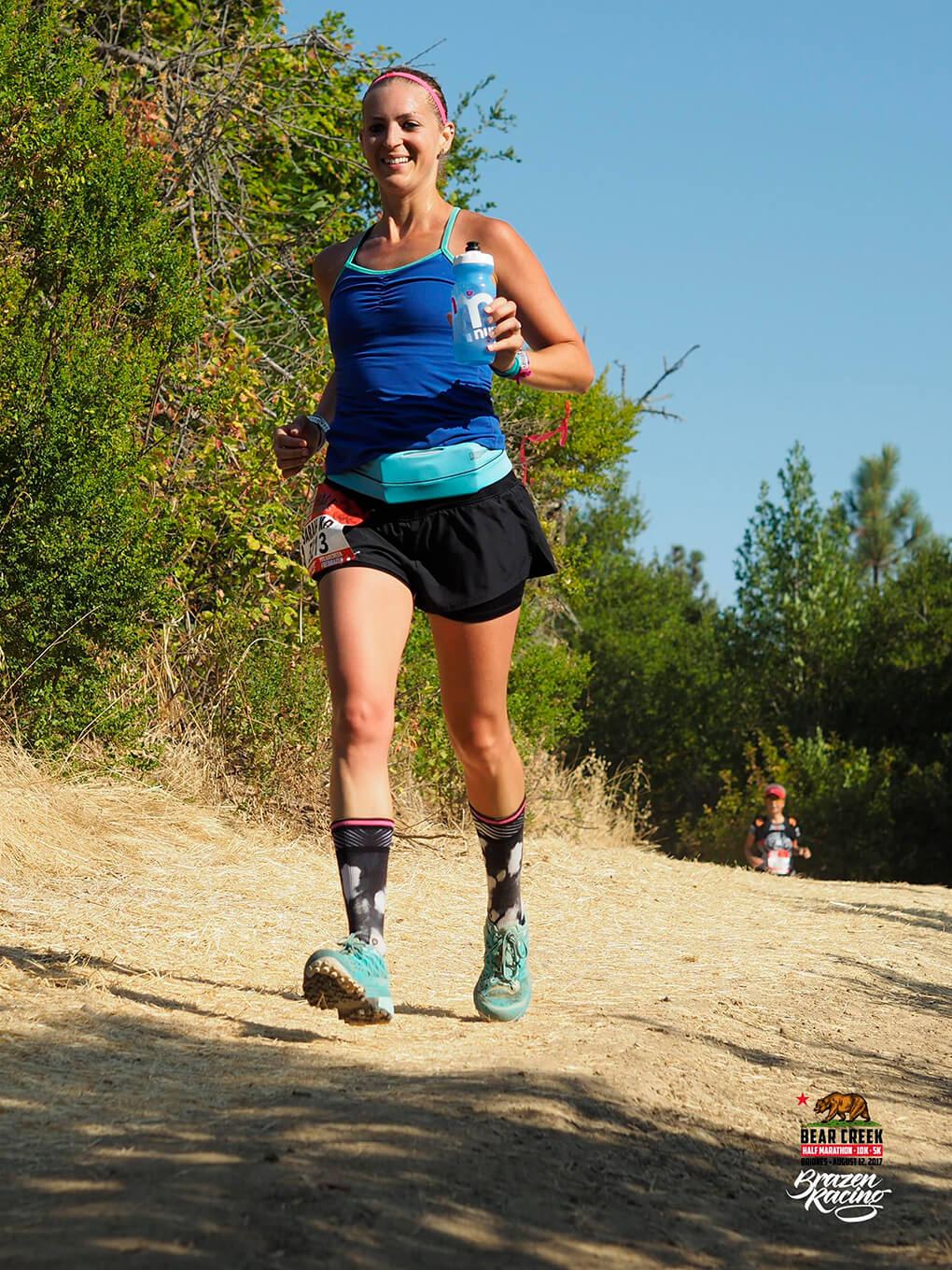I’ve entered a little half marathon training confusion.
Week 2 of my Rock ‘n Roll Las Vegas 1/2 Training was a success! But like most successes in life, it didn’t come without road bumps along the way.
Workouts from last week
- Monday = 3 miles + strength
- Tuesday = 6 * 800
- Wednesday = 3 miles + strength
- Thursday = 45-minute tempo
- Friday = 8.35 miles
- Saturday = stretching + light abs
- Sunday = off
I wanted the whole weekend off from running – two full days to rest, relax and recover. I tackled the 8-miler on Friday night. I began around 4:30 pm, and I figured this would be great because it would allow me to see how I adjust to running at that time of the day. I am an early morning runner, but the Rock ‘n Roll is at night this year. I’ve never run a half at that time of the day. (Anyone with Colitis knows this could present problems.)
The run as a whole was a success. I ran outside and actually ended up slightly over 8 miles since I was running outside (I mean c’mon, like my Nike shirt says, “How am I going to get home if I stop running?”).
Half Marathon Training Confusion
And now for the confusion: Miles 1-4-ish I have a major lack of energy. It takes all the mental energy I have to continue on. But then around mile 5, I get a huge burst of energy. I’m barely breathing heavily, and I could soar. And then issue #2 settles in –> my legs get so sore and achy and that slows me down. Finally, upon finishing these longer runs, I feel nauseous for about an hour afterward.
I am left to wonder….is this just weakness leaving my body?

It’s all very bizarre.
Question: Does this happen to you while training? What do you do? How do you train for and around it?
Updated in 2017: This image was taken from my Brazen Racing passion.
Xox,
SKH
🤰 bloating be gone! weight loss through optimal gut health for women
💃ʜᴇᴀʟ ʏᴏᴜʀ ɢᴜᴛ. ʜᴇᴀʟ ʏᴏᴜʀ ʟɪfe.
🫶🏻 founder gutbyome.com







I have SO many thoughts about this. Warning: this is going to be a blog-post-sized comment.
First of all, get and read Matt Fitzgerald’s book about running by feel. It offers some terrific insights on why the best training plan for you is the one that WORKS for you, and works with your schedules and circadian rhythms and nutritional needs and job and family and competing demands. If a training plan asks you to change everything, including things you KNOW work for you, it’s not the right training plan. This is especially true when you’re a self-coached non-professional runner without unlimited resources to help you adapt to a new plan. Matt’s book is one of the best I’ve read .
Secondly, it sounds like it takes you some time to ease into your run. A certain amount of this is normal, and not worth stressing about, but up to four miles of easing into your run seems like a lot to me. I’m wondering if you’re adequately fueled when you start. If you go into a run hungry or thirsty, you can feel bonky and cranky and off your game. I know you have some specific nutritional needs that make this challenging for you, but you’ve got to figure out a way to get some calories in within 2-3 hours of your run. Bananas, nuts, peanut butter, anything that’ll give you a quick hit will help. I’d also suggest trying to create an everyday route that has something compelling in the first 1-4 miles–a nice view, a long uninterrupted stretch where signals won’t break your rhythm, a short hill that gives you a focal point, an area where you’re likely to see lots of other runners and zone out thinking about them rather than about your discomfort, etc. I think if we can figure out how to get you into your run well-fueled and to help you dissociate for the first few miles while you ease into your stride, you’ll be better off.
Third, the issue with your legs getting sore is something that will improve if you a) get more comfortable with this distance (i.e., run it more frequently) and b) focus on your core when you cross train, because if your core works hard for you while you run, your legs won’t have to work as hard. You may also want to wear compression socks. A lot of runners find that they help slow fatigue and speed recovery. Mostly, though, I’d emphasize running the distance more often. You’ll find that your legs will come to regard 8 miles as the new 5 miles, and then 11 miles as the new 8 miles, and so on.
Third, you are absolutely not alone in experiencing that nasty strung-out post-run icky feeling. I think just about all runners have been there. In my experience (and many friends agree), the trick is to have some kind of food waiting for you immediately post-run that you know you can choke down and you know will agree with you. Something simple and bland is best. If you get a few calories in right after the run, I suspect you’ll feel better an hour or two later. Otherwise, you’ll find yourself in that weird hungry/nauseous/cranky/uncomfortable state, and if you let yourself get that far, NOTHING will be appealing and you’ll just have to wait it out longer. (I often schedule a stop at Trader Joe’s for right after my long run, because I’ve found that the sample-size cup of coffee and whatever food they’re sampling totally hits the spot. Your mileage, of course, will probably vary!)
Regarding your oddly timed run, I’d suggest coming up with a pre-run routine that you can stick to at any time of day, a routine that tells your mind and body, “It’s time to run.” I’ve found this really useful when I’ve run long-distance relays, which require you to run at all kinds of strange hours of the day and night. If I put on my lucky socks and listen to a well-worn playlist and eat a handful of Lucky Charms (yep, I’m serious) and close my eyes and tell myself, “It’s go time, and you know what to do,” my body will follow my mind’s cue every single time.
By the way, I’ve learned all these things by trial and error. It’s the best way to learn anything. Don’t be afraid to try stuff. Remember that every running book is a record of the author’s trial and error, nothing more. You have to write your own running book. Learning from others is great, but ultimately you’ll learn things that only apply to you. Remember them and use them. They’re your best resource.
Good luck!
Sarah,
I am not a runner, but I consult for a company that works with marathoners and ultra-marathoners. What you described about the zap of energy and then the breakthrough was probably your body being overwhelmed by lactic acid and then finally catching up. This is very common with long distance runners – usually described as the wall. The company I consult for, pH Sciences Inc., has developed a product that has been used by runners for about 8 years. It is now being sold through a company called Yoli under the trade name Alkalete. I’ve included the web site, http://www.AcidBuffer.com and you can try your first bottle of vegetable capsules by just paying the shipping and handling. Most runners see significant results within 5 days or less. It’s definitely worth a try.
When you get to the site, you will have to enter some information into a landing page. This information is never sold, nor used in any other way. Once inside the site, scroll down until you see the link that reads: Get a FREE 15-Day Trial of Alkalete ($40 Value) and click on it to get your free bottle.
If you have questions, I’ve included my email address and my phone number is 253-222-5294.
Good luck with your training!
Rod
Congrats on the success so far! Having just completed the first two of three planned 1/2s this year I’ve experienced all sorts of odd mental and physical challenges! I don’t think you are unusual starting off flat and hitting your stride a few miles in; in fact I’m the same way! It takes me a good 3 miles until I establish a decent tempo that feels good and is at goal pace. The further I go, and train to go, the further this comfort zone lies. If I’m doing 15 I takes me 4 to 5, so in the absence of knowing why, I accept it and work with it! The second part of your challenge is a bit more vexing, it could be part mental but u suspect that your body just isn’t “there” yet! The further you go, the further you’ll be able to go! So don’t get to worried about it this early on! Give your body some time to adapt and grow stronger and it should make a big difference. Oh yeah, while I’m at it don’t skimp on the rest! That was my biggest mistake early on and it cost me! I found that by listening to my body I can give it what it needs.
Keep up the great work!
Hi Dave!
Thanks for stopping by and the great comment. The weird thing about the pain this time is just that I never had it before while training. I have also done two 1/2 marathons, so it’s weird to have these aches now. Were you able to read what Clover wrote? She may be on to something with me, and I might just need to keep on it. I’m a little anxious, and yet so excited, to tackle 9 this Friday. I’ll report back. For now?! 1600 repeats tomorrow! Thanks again!
I totally relate to the feeling of “oh my gosh, I’ve only hit half a mile and I’m over this.” I would just say that you need to be mindful of your pace and when you hit your stride, don’t try to go past it, unless that’s what you’re trying to do. When it comes to the long runs, I like to have the mindset of slow and steady. I can typically deal with the 10+ milers okay, but then when I am done with a Half, my legs are pissed at me. Compression socks can definitely help with that. A good pair of compressive tights are a must have, too, at least for me. I totally agree with Clover; a strong core is essential. I cross train with Pilates and something called CoreAlign (Pilates-ish, but standing), plus pushups.
As for an alternative to the rockin’ fanny pack, I swear by the SPI belt. It expands or contracts and doesn’t bounce around a lot. I keep my iPhone, keys, dog poop bags, gel packs, and a tube of lip balm in there. I think I may have even put gloves in there at one time, too!
Hope this helps!
Hi Beth!
Thanks for stopping by and all the great comments. I agree with the core training as well. I’ve been doing much more of it, and I’ve incorporated 1-2 times of yoga in per week. I will check out some compression socks. Do you know where I can get the SPI belt? Thanks again:)
Clover –
WOW. JUST WOW! I can’t thank you enough for all of this. Implementing them right…..NOW!!! I must get the book you recommend, too. I’m doing my 9-miler this Friday, same time, same place as last Friday. I will report back:) I am so grateful for you, Clover!